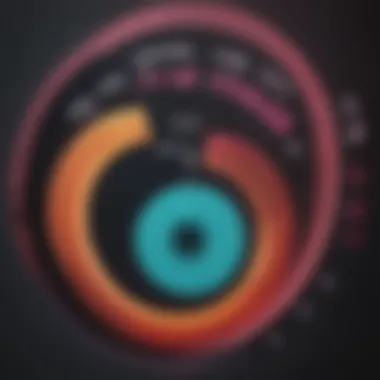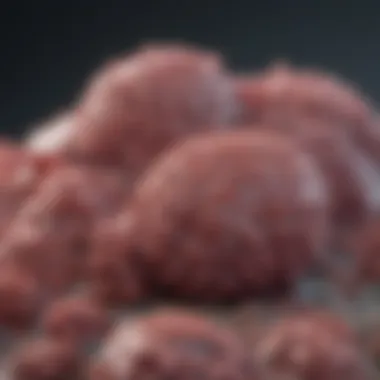In-Depth Examination of Renal Cancer Screening


Intro
Renal cancer screening serves as a pivotal element in the early detection and treatment of kidney malignancies. This field has gained increasing attention due to its potential to improve patient outcomes significantly. Understanding the systematic approach to screening can empower healthcare professionals and patients alike.
Research Overview
Key Findings
Recent studies have indicated that renal cell carcinoma (RCC) screening can lead to earlier diagnosis and enhanced survival rates. Key findings from various research indicate that patients with high-risk factors, such as family history and specific genetic predispositions, significantly benefit from regular screening. The incorporation of advanced imaging technologies like contrast-enhanced ultrasound and MRI has also been essential in improving diagnostic accuracy.
Study Methodology
Researchers often employ a combination of retrospective and prospective cohort studies to gather data on screening methodologies. Surveys and clinical trials are also common, focusing on patient demographics, risk factors, and outcomes post-diagnosis. This multifaceted approach allows for a robust analysis of the effectiveness of screening protocols over time.
Background and Context
Historical Background
Historically, renal cancer screening was not standardized and relied primarily on symptomatic presentation. As medical technology evolved in the late 20th century, imaging techniques became widespread, facilitating earlier and more accurate diagnoses.
Current Trends in the Field
Today, the field is moving towards more tailored screening recommendations based on individualized risk assessments. Genetic profiling is increasingly a part of this approach, helping to identify those at higher risk for developing renal cancer. Healthcare providers now use a variety of imaging methods, emphasizing the significance of both patient education and awareness in promoting early detection.
Intro to Renal Cancer Screening
Renal cancer screening serves as a vital component in the early detection and management of kidney tumors. As incidence rates rise globally, understanding screening protocols becomes increasingly important. This section emphasizes the significance of renal cancer screening by elucidating its definition, importance, and current trends in renal cancer incidence.
Definition and Importance
Renal cancer refers to malignancies that occur in the kidneys. Early detection is crucial, as it significantly influences treatment success and patient outcomes. Screening facilitates the identification of asymptomatic renal tumors, which can be vital for improving prognoses.
Screening recommendations seek to provide a standardized approach to identifying individuals at higher risk. These include those with a family history of renal cancer or other related conditions. An established screening process can guide healthcare professionals in determining appropriate intervention strategies, thus enhancing clinical decision-making.
Current Trends in Renal Cancer Incidence
In recent years, the global landscape of renal cancer incidence has shown concerning shifts. Statistics indicate a rise in renal cancer cases, particularly in older adults and individuals with specific risk factors. Factors contributing to this increase include obesity, hypertension, and smoking, among others.
Recent research underscores the importance of tailored screening efforts that consider these trends. For example, in certain populations, enhanced awareness and regular screening could lead to earlier diagnosis. Additionally, improved imaging technologies may allow for earlier detection of tumors. Understanding these trends is essential for guiding policy decisions and healthcare resource allocation.
Early detection remains one of the most significant factors affecting survival rates in renal cancer. Early treatment yields better outcomes.
Overall, renal cancer screening is a vital aspect that directly impacts patient care. As trends in incidence evolve, so must our approaches to screening, ensuring we manage and mitigate risks effectively.
Understanding Renal Cancer
Renal cancer represents a significant health challenge, affecting thousands each year. Understanding its nature and implications is crucial for effective screening and early intervention. This section will elaborate on the types of renal cancer and the symptoms and risk factors associated with it. This understanding not only aids in identifying those at risk but also provides insights into the relevant screening methods that professionals should consider.
Types of Renal Cancer
Renal cancer primarily encompasses several distinct types, each exhibiting unique characteristics. The most prevalent type is renal cell carcinoma (RCC), accounting for approximately 85% of all cases. RCC includes several subtypes:
- Clear cell carcinoma: This is the most common subtype, noted for its clear cells when viewed under a microscope.
- Papillary carcinoma: This type often arises in the context of hereditary conditions and is characterized by its papillary structures.
- Chromophobe carcinoma: Less common, it originates from the intercalated cells of the renal tubules and tends to have a better prognosis compared to other types.
Additionally, there are rarer forms of renal cancer, such as Wilms tumor, a pediatric malignancy, and collecting duct carcinoma, which is notably aggressive. Understanding these types is paramount, as they present different clinical challenges and require varying approaches to screening and treatment.
Symptoms and Risk Factors
Awareness of symptoms and risk factors is essential in the context of renal cancer screening. Many patients may be asymptomatic in the early stages, which underscores the importance of regular monitoring for at-risk groups.
Common symptoms include:
- Hematuria (blood in urine)
- Persistent lower back pain
- Unintended weight loss
- Fatigue
- Fever that is unexplained


These symptoms might also relate to other health conditions, which complicates early detection.
Factors that elevate the risk of developing renal cancer include:
- Smoking: Known to significantly increase the risk.
- Obesity: A correlation has been noted between high body mass index (BMI) and renal cancer incidence.
- Hypertension: This condition is linked with a higher occurrence of renal cancer.
- Family history: Genetic predispositions exist, particularly with syndromes like von Hippel-Lindau.
These considerations are vital for identifying candidates for screening and tailoring health interventions accordingly. Screening protocols can be better optimized by factoring in these elements, enhancing the overall efficacy of early detection efforts.
"Understanding renal cancer and its risk factors is fundamental for effective screening. It aids in identifying those who may benefit most from early detection strategies."
In summary, a comprehensive understanding of renal cancer types and risk factors equips healthcare professionals and researchers with the necessary tools to improve screening guidelines. This ultimately contributes to better patient outcomes and enhances the efficiency of cancer management strategies.
Screening Methodologies
Screening methodologies in renal cancer play a critical role in early detection and successful management of this disease. Early identification of renal cancer significantly improves the treatment outcomes and enhances patient survival rates. Different techniques and approaches are essential to diagnose renal cancer effectively. In this section, the focus will be on various screening methodologies, including imaging techniques, laboratory tests, and biopsy procedures. Each method’s unique attributes, benefits, and limitations will be discussed to provide a comprehensive understanding of how these methodologies facilitate renal cancer screening.
Imaging Techniques
Imaging techniques are intrinsic to the early detection of renal cancer. They serve as a non-invasive means to visualize internal structures and identify abnormalities that may signify renal tumors. Each imaging modality has its strengths and limitations, which influence its applicability based on patient-specific factors.
Ultrasound
Ultrasound is a widely used imaging technique for renal cancer screening. One of its key characteristics is that it employs high-frequency sound waves to create images of the kidneys. This method is particularly beneficial because it is safe, involves no radiation, and is typically less expensive than other imaging options.
A unique feature of ultrasound is its ability to assess blood flow within the kidney vasculature. This can provide additional insights into the nature of detected lesions. However, its limitations include operator dependency and reduced accuracy in evaluating small lesions.
CT Scan
The CT scan, or computed tomography, is another important tool in renal cancer screening. Its high sensitivity in detecting renal masses makes it a prominent choice. The ability to provide detailed cross-sectional images allows for better assessment of tumor size, location, and potential metastasis.
A significant advantage lies in its rapid execution, making it suitable for various clinical settings. Nevertheless, the use of contrast agents poses risks, such as allergic reactions or nephrotoxicity, particularly in patients with pre-existing renal impairment.
MRI
MRI, or magnetic resonance imaging, is a sophisticated imaging modality that offers excellent soft tissue contrast. This characteristic is especially useful in differentiating between benign and malignant lesions. MRI is beneficial for patients who cannot undergo CT scans due to allergies to contrast material.
A unique feature of MRI is its functional imaging capabilities, which can show dynamic changes in blood flow and tissue perfusion. However, MRI is more time-consuming and typically more expensive than other methods, which can be a consideration in busy clinical practices.
Urinalysis and Blood Tests
Urinalysis and blood tests are crucial components of renal cancer screening. These tests can offer valuable insights into the kidney's health and provide preliminary evidence of potential malignancies.
Urinalysis includes the assessment of urine samples for red blood cells, white blood cells, and abnormal chemical compounds such as proteins. Detecting hematuria, or blood in the urine, can be an early indicator of renal cancer.
Blood tests, including serum creatinine and blood urea nitrogen levels, can help evaluate overall kidney function. Biomarkers such as CA-IX or the evaluation of urine cytology may also aid in the assessment of any malignant cell presence.
Biopsy Procedures
Biopsy remains a definitive method for diagnosing renal tumors. This procedure involves extracting a small sample of kidney tissue for histopathological analysis. There are various types of biopsy procedures, including percutaneous, laparoscopic, or open surgical biopsy.
Percutaneous biopsy is often preferred due to its minimally invasive nature, though it relies heavily on imaging guidance to ensure accurate targeting of the tumor. Obtaining a tissue sample facilitates the diagnosis and helps in deciding the best course of treatment.
However, there are risks associated with biopsy, including bleeding and infection. Therefore, careful patient selection and pre-procedure assessment are essential to mitigate complications.
Efficacy of Screening Techniques
The efficacy of renal cancer screening is critical for early diagnosis and successful treatment outcomes. Understanding how screening techniques function allows healthcare providers to identify patients at risk effectively. Early detection can significantly improve survival rates and quality of life for individuals diagnosed with renal cancer. This section focuses on the two essential elements of efficacy: sensitivity and specificity. Furthermore, it presents a comparison of various screening methods available today.
Sensitivity and Specificity
Sensitivity and specificity are key metrics that determine the effectiveness of cancer screening tests.
Sensitivity refers to a test's ability to correctly identify individuals with a disease. In the context of renal cancer, a high sensitivity means that the screening method detects most cases of the disease. If a test shows high sensitivity, few false negatives occur, which is crucial since missing a diagnosis can have serious consequences for patient outcomes.
On the other hand, specificity pertains to the ability of a test to accurately identify individuals without the disease. A highly specific test ensures that healthy individuals are correctly ruled out. High specificity minimizes false positive results, which can lead to unnecessary anxiety and invasive procedures for patients.


Efficacy is achieved when a screening method balances these two metrics. A method with high sensitivity and specificity reduces both false negatives and false positives. In renal cancer screening, the ideal scenario is achieving a high percentage in both areas, thus ensuring that most patients are accurately diagnosed without overwhelming them with unnecessary follow-up tests.
Comparison of Screening Methods
Several screening methods are currently used for renal cancer detection. Each has its own strengths and weaknesses, impacting their overall efficacy.
- Ultrasound: This imaging technique is non-invasive and has a good sensitivity in detecting renal masses. However, its specificity can sometimes be limited due to the inability to differentiate between benign and malignant tumors without further testing.
- CT Scan: The computed tomography scan offers high sensitivity and specificity. It is excellent for visualizing renal anatomy and detecting small tumors. However, there are considerations regarding exposure to radiation, especially in younger patients or when multiple scans might be necessary for monitoring.
- MRI: Magnetic resonance imaging does not involve radiation exposure and provides superior soft tissue contrast. Its sensitivity for renal masses is high, but it is often less available and more expensive compared to other imaging techniques.
A comprehensive screening program must consider the specific context of patients, taking into account their individual risk factors and medical history. Balancing the attributes of different screening methods against their implications for patient management is central to improving screening guidelines.
"The choice of a screening method should guide clinical practice towards maximizing the benefits of early detection while minimizing the risks associated with unnecessary diagnoses."
In summary, understanding the efficacy of screening techniques is essential for optimizing renal cancer detection. By focusing on sensitivity and specificity, healthcare providers can select methods that offer the best chances for early detection and effective patient management. As new techniques emerge, ongoing research is vital to improve the current state of renal cancer screening.
Role of Genetic and Family History
The role of genetic and family history in renal cancer screening is crucial for identifying individuals at higher risk. This factor significantly shapes screening strategies and personalizes recommendations based on individual predisposition. A deeper understanding of genetic influences can lead to more effective preventive measures and timely interventions. Detecting renal cancer early can markedly improve treatment outcomes, making it vital to integrate genetic considerations into screening protocols.
Genetic Predisposition to Renal Cancer
Genetic predisposition to renal cancer refers to inherited genetic mutations that elevate cancer risk. Notably, mutations in genes such as VHL, MET, and FLCN have been researched in relation to renal cell carcinoma. These mutations disrupt normal cellular functions and lead to malignant transformations. Individuals carrying such genetic alterations may not only face higher risks but also have implications for their family members.
A study showed that individuals with a family history of clear cell renal carcinoma had significantly increased cancer risk compared to the general population. Moreover, genetic testing can identify at-risk individuals who might benefit from enhanced surveillance. Such findings emphasize the importance of assessing genetic backgrounds during routine screening assessments, as it helps target efforts to those most likely to benefit.
Family History and Screening Recommendations
Understanding family history is a key component in renal cancer screening recommendations. A positive family history of renal cancer is a strong indicator that screening should be escalated. Guidelines often suggest that individuals with a first-degree relative diagnosed with renal cancer should begin screening at an earlier age compared to standard recommendations.
In practice, several factors are taken into account when considering screening for those with familial risk:
- Age of onset in relatives with renal cancer
- Number of affected family members
- Specific types of renal cancer observed in the family
Many professional societies now advise tailored screening protocols for high-risk individuals, including:
- Regular imaging assessments, primarily ultrasound or CT scans, to monitor kidney health.
- Periodic genetic counseling to guide family members about their risks and testing options.
- Education on lifestyle modifications that could mitigate risk factors associated with renal cancer.
"Understanding family history may not only aid in personal risk assessment but also in informing future generations about their potential risks."
Screening Guidelines and Recommendations
The importance of screening guidelines and recommendations in renal cancer cannot be overstated. These guidelines serve as a framework that outlines best practices for healthcare providers to follow, ensuring that patients at risk receive appropriate evaluations and necessary interventions. By standardizing approaches to screening, healthcare professionals can enhance early detection rates, reduce morbidity, and ultimately improve patient outcomes.
Professional Society Guidelines
Professional societies, such as the American Urological Association and the National Comprehensive Cancer Network, provide well-researched guidelines that form the backbone of renal cancer screening practices. These guidelines are drafted based on comprehensive studies and expert consensus, focusing on:
- Risk Assessment: Identifying individuals at higher risk due to factors like family history, genetic predisposition, or previous kidney conditions.
- Recommended Screening Intervals: These guidelines suggest how often high-risk individuals should undergo screening tests. Regular intervals can lead to timely detection of abnormalities.
- Approved Testing Methods: Using validated methods, such as imaging techniques and laboratory tests, ensures reliable results for evaluating potential renal cancers.
"Adhering to professional society guidelines is key for physicians to optimize screening strategies and contribute to better health outcomes in at-risk populations."
These standardized recommendations help to align practices across various medical settings, ensuring consistency and quality in patient care.
Individualized Screening Approaches
While following professional society guidelines is crucial, individualized screening approaches also play an important role. Each patient has unique characteristics and risk factors that may warrant a tailored screening plan. Healthcare providers should consider:
- Patient’s Medical History: Individual factors like previous cancer history or other health conditions can affect screening needs.
- Personal Preferences: Patients may have different comfort levels regarding the invasiveness and frequency of screening.
- Emerging Research: New data and findings may suggest modifications in screening recommendations, which can be personalized according to an individual risk assessment.
Determining the right balance between standardized and individualized approaches can significantly enhance the effectiveness of renal cancer screening programs. This tailored method addresses the varied needs of the patient population, aligning with the broader objective of precision medicine.
Challenges in Renal Cancer Screening
The topic of challenges in renal cancer screening is crucial, as it sheds light on the complexities involved in the timely detection of this disease. Although screening has the potential to save lives by enabling early diagnosis, it also comes with a host of challenges that require consideration. Understanding these challenges can help improve screening protocols and patient outcomes.


False Positives and Negatives
False positives and negatives present significant challenges in renal cancer screening. A false positive occurs when a screening test incorrectly indicates the presence of cancer, leading to unnecessary anxiety and possibly invasive follow-up procedures. This can strain healthcare resources and lead to increased costs.
Conversely, false negatives can be even more troubling, as they may result in missed diagnoses. If a screening fails to identify renal cancer, the condition may progress undetected, jeopardizing the patient's chances for successful treatment.
- Factors Contributing to False Results:
- Limitations in the sensitivity of imaging techniques such as CT and MRI.
- Variability in interpretation of imaging results by different radiologists.
- Biological factors such as tumor location and type, affecting detection rates.
Research indicates that enhancing the accuracy of screening technologies is essential to minimizing both false positives and negatives.
Cost-Benefit Analysis of Screening
A comprehensive cost-benefit analysis of renal cancer screening is necessary for evaluating its overall effectiveness. While screening can lead to early detection and improved outcomes, there are costs associated with various screening methods, including imaging and laboratory tests.
Healthcare systems must consider the following aspects:
- Direct Costs:
- Indirect Costs:
- Expenses related to screening procedures like ultrasound, CT scans, and blood tests.
- Costs arising from follow-ups and confirmatory tests to validate screening results.
- Time lost from missed work due to diagnostic procedures.
- Emotional toll on patients and families related to false positive results.
In assessing the widening gap between screening benefits and associated costs, a balance must be struck that promotes effective screening without placing an undue burden on patients and the healthcare system.
Patient Compliance and Awareness
Patient compliance is another significant challenge in renal cancer screening. For screening programs to be effective, patients must not only be aware of the benefits but also of the recommended guidelines. Ensuring that patients understand the importance of regular screening can encourage better participation.
- Strategies to Enhance Compliance:
- Educational initiatives targeting high-risk populations to raise awareness about renal cancer.
- Simplifying the appointment process to make it easier for patients to participate in screenings.
- Addressing common misconceptions that may lead to reluctance in undergoing screening.
Ultimately, raising awareness and improving compliance are integral for the success of renal cancer screening programs. Both healthcare providers and public health initiatives must prioritize these aspects in their efforts to combat the disease effectively.
Future Directions in Renal Cancer Screening
Renal cancer screening is evolving rapidly. The landscape of patient management is shifting as new technologies and methods emerge. This section will discuss the future directions in renal cancer screening and their potential impact on detection and treatment.
Emerging Technologies
Advancements in technology are set to revolutionize screening standards. New imaging modalities are being developed for early detection. Techniques like enhanced MRI and high-resolution ultrasound can provide improved sensitivity. These technologies may help in identifying small tumors that traditional methods might miss.
The integration of artificial intelligence into imaging is also noteworthy. AI algorithms can analyze vast amounts of imaging data quickly and accurately. They can assist radiologists in identifying abnormalities and prioritizing cases that require immediate attention. The potential of automated systems to reduce human error is significant. Furthermore, wearable technology is emerging as an option for continuous monitoring, which can lead to earlier diagnoses in high-risk individuals.
Research and Development in Biomarkers
Biomarkers play a crucial role in renal cancer screening. Ongoing research focuses on identifying new biomarkers that can indicate the presence of renal cancer at an early stage. This could lead to blood tests that complement traditional imaging methods. For instance, studies are exploring circulating tumor DNA and other biological markers. They can provide insights into tumor characteristics and help in monitoring treatment responses.
The use of genetic profiling also shows promise. Understanding genetic predisposition to renal cancer can lead to tailored screening protocols. Individuals with certain genetic markers may benefit from more frequent screenings. Identifying these markers can improve risk assessment approaches, leading to early intervention strategies that are more personalized.
"Emerging technologies and biomarkers hold tremendous potential for transforming renal cancer screening practices, paving the way for earlier diagnosis and more effective management."
Overall, the future of renal cancer screening depends on these evolving technologies and the continuous research into biomarkers. Their practical application could lead to a paradigm shift in how renal cancer is detected, treated, and managed.
Epilogue
In summary, the examination of renal cancer screening reveals critical insights into its significance and challenges. The importance of this topic lies in its potential to enhance early detection and improve treatment outcomes, ultimately leading to better prognosis for patients. Screening methodologies, including imaging techniques and biomarker development, serve as pillars for efficient renal cancer detection.
Summary of Key Points
- Screening Importance: Early detection of renal cancer significantly increases survival rates.
- Methodologies: Various screening technologies exist, such as ultrasound, CT scans, and emerging biomarkers.
- Challenges: False positives and negatives, along with the economic implications of screening, remain ongoing concerns.
- Guidelines: Professional societies provide recommendations tailored to individual risk profiles, emphasizing personalized approaches.
Implications for Future Research and Practice
Future endeavors in renal cancer screening research must address the existing gaps in knowledge, particularly regarding risk assessment and the refinement of screening programs. Areas worthy of investigation include:
- Emerging Technologies: Innovations in imaging and blood tests could revolutionize early detection strategies.
- Family History: Recognizing the role of family history in screening protocols can lead to earlier interventions in genetically predisposed individuals.
- Patient Compliance: Understanding factors influencing patient adherence to screening recommendations can optimize outcomes.
Ultimately, continuous improvement and adaptation of screening practices is essential to navigate the complexities of renal cancer, ensuring better healthcare delivery and patient outcomes.







